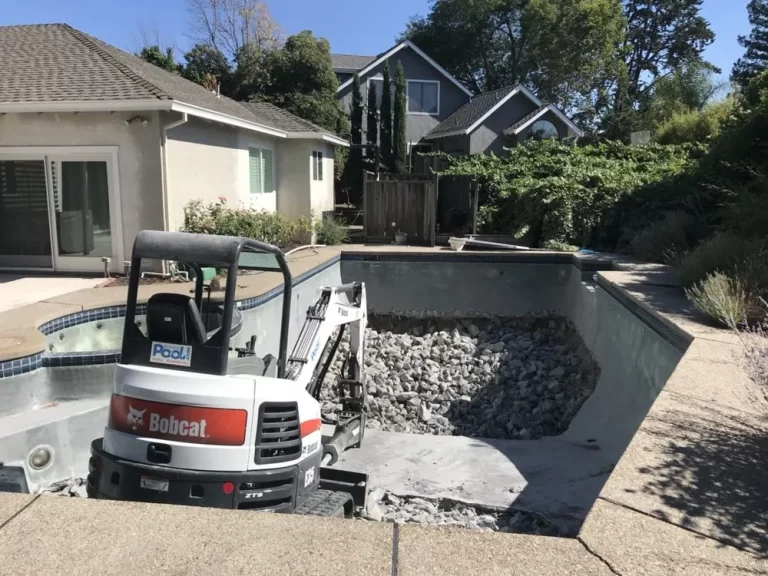Comparing Pool Removal vs. Pool Renovation: Expert Insights and Recommendations
Owning a swimming pool can be a luxurious asset to a home, providing a private oasis for relaxation and entertainment. However, there comes a time when every pool owner must weigh the options of pool removal or pool renovation. This decision can be a tough one, as both options have their benefits and drawbacks, depending on the specific circumstances surrounding the pool.
Pool renovation, also known as pool remodeling, is a popular choice for those who want to extend the life and value of their swimming pool. This process typically involves updating and modernizing the pool’s overall appearance and functionality, such as installing new tiling, coping, or an updated filtration system. On the other hand, pool removal is the option for those who no longer wish to maintain their pool or need the extra yard space for other uses.
In this article, we will discuss the factors to consider when making this important decision and delve deeper into the pros and cons of pool removal and pool renovation. With a clear understanding of both options, homeowners will be better equipped to make an informed choice about the future of their swimming pool.
Evaluating Pool Renovation Options
Renovation Benefits and Considerations
When deciding on pool remodeling or renovation, it is important to weigh the benefits and considerations. Pool renovation can significantly upgrade the aesthetics and functionality of an inground pool, which may include a vinyl liner, concrete pool, or fiberglass pool. Renovating an old pool can include various updates such as resurfacing, installing new pool lighting, adding a pool heater, water features, tanning ledges, or even a pool slide.
One major reason for pool renovation is enhancing pool maintenance by replacing old plumbing, pool tile, or other outdated components. Another important factor to consider is the impact of landscaping on the pool design, which may also need updating during the renovation process.
Design and Materials
There are numerous options when it comes to design and materials for pool remodeling. Let’s take a look at some popular choices:
- Size and shape: Pool owners might wish to adjust the size or shape of their existing pool by extending or modifying the pool structure.
- Resurfacing: Choices for resurfacing include versatile plaster, pebble surfaces for a more natural look, and glass bead finishes for a shimmering effect. These options vary in cost, durability, and overall aesthetic appeal.
- Pool tile: Updating pool tile can add a fresh look to a pool’s waterline, steps, or other features.
- Coping and decking: Changing the coping or decking materials around the pool can improve aesthetics and safety, with options like flagstone, pavers, or poured concrete.
Understanding Renovation Costs
Pool remodeling costs vary depending on the extent of the renovation, materials used, and the location of the pool. Here’s a brief outline of potential costs for common updates:
| Update | Estimated Cost Range |
|---|---|
| Resurfacing | $4,000 – $15,000 |
| Pool Heater Installation | $1,500 – $4,000 |
| Pool Lighting | $150 – $900 (per light) |
| Water Features | $1,000 – $7,500 |
| Tanning Ledge | $2,500 – $7,000 |
| Pool Slide | $1,000 – $4,000 |
| Plumbing Replacement | $2,000 – $4,000 |
It is crucial to evaluate various renovation options in terms of cost, benefits, and overall impact on pool maintenance and aesthetics. Consulting with a professional pool renovation expert can help homeowners make informed decisions and attain the desired outcome for their pool remodeling project.
Considering Pool Removal
When deciding on what to do with an aging or unwanted swimming pool, homeowners often weigh the options between pool removal and pool renovation. In this section, we will focus on pool removal, exploring the different types, associated costs, and benefits that come with it.
Types of Pool Removal
There are two primary methods for pool removal: partial pool demolition and complete pool removal.
- Partial pool demolition involves only removing part of the pool structure, typically the top 18-36 inches. The remaining pool shell is then punctured to allow for drainage, and the hole is filled with dirt and compacted.
- Complete pool removal entails complete excavation and removal of the entire pool structure, including all associated plumbing and electrical systems. This method leaves no trace of the former pool and allows for greater flexibility in landscape design and future use of the outdoor space.
Both methods have their advantages and disadvantages, depending on the specific needs of the homeowner and the desired outcome for the property.
Costs and Factors in Pool Removal
When considering pool removal, one must account for various factors that can impact the overall cost. Some of the main elements include:
- Type of pool removal: As mentioned before, there are two main methods, and each comes with its associated costs. Complete pool removal is generally more costly due to the additional labor and materials needed.
- Labor and equipment: Pool removal requires specialized equipment and experienced professionals to carry out the job safely and efficiently. The cost of labor and tools will greatly affect the overall cost.
- Pool materials: The construction materials of the pool (concrete, fiberglass, or vinyl) will also play a role in determining the cost and complexity of the removal process.
- Size and depth: Larger and deeper pools require more labor and materials to remove, which can increase the overall cost.
- Permits and fees: Some localities may require permits for pool removal, which can add to the overall cost of the project.
It’s essential to obtain multiple quotes from reputable contractors before deciding on a pool removal option.
Benefits of Removing a Swimming Pool
There are several benefits to removing a swimming pool, including:
- Increased property value: For some properties, removing an old, unattractive pool can actually increase the property value by creating a more desirable landscape and additional usable outdoor space.
- Reduced maintenance costs: By removing a pool, homeowners no longer need to deal with the ongoing costs associated with pool maintenance, including chemicals, cleaning, and repairs.
- Enhanced aesthetics: Filling in a pool can provide the opportunity to greatly improve the overall appearance of the yard, adding new landscaping or additional outdoor living areas.
- Greater privacy: For those who feel their pool is no longer private or enjoyable, removing it can allow for a more secluded and peaceful backyard environment.
In summary, when comparing pool removal with pool renovation, homeowners should carefully assess their requirements and preferences while taking into account the types of pool removal, costs, and benefits.






